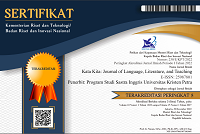Semiotic Analysis of Sephora’s Beauty Campaign Video
(1)
(*) Corresponding Author
Abstract
Social campaign has gained its popularity over these past years. With the rapid business development, many brands compete with each other to create a simple campaign video but still has a meaningful story. To analyze the data, the writer use semiotic approach. This study aims to discover the meaning of verbal and visual signs, and in what ways those meanings are conveyed in Sephora’s The Unlimited Power of Beauty video. The findings show that in The Unlimited Power of Beauty video, Sephora strives to redefine the term of beauty which cannot be determined merely by particular criteria such as having a white and flawless skin, but beauty can be defined in all forms, sizes, and ages through the verbal and visual signs.
Keywords
Full Text:
PDFReferences
About Dark is Beautiful.(n.d.). https://www.darkisbeautiful.in/about/
American Psychological Association. (2012). Aging and Depression. American Psychological Association. https://www.apa.org/topics/aging-end-life/depression
Botella, J. B. (2021, April 14). Sephora – The unlimited power of beauty. [Video File]. Vimeo. https://vimeo.com/536829430
Chandler, D. (2017). Semiotics: The basics (3rd ed.). Routledge Taylor & Francis Group
Danesi, M. (2004). Messages, Signs, and Meanings: A Basic Textbook in Semiotics and Communication Theory (3rd ed.). Canadian Scholars' Press.
Ebner, N. C., Luedicke, J., Voelkle, M. C., Riediger, M., Lin, T., & Lindenberger, U. (2018). An Adult Developmental Approach to Perceived Facial Attractiveness and Distinctiveness. Frontiers in Psychology, 9. https://doi.org/10.3389/fpsyg.2018.00561
Fenell, M. (2016). Overcoming low self-esteem: A self-help guide using cognitive behavioural techniques. Hachette UK.
He, D., Workman, C. I., Kenett, Y. N., He, X., & Chatterjee, A. (2021). The effect of aging on facial attractiveness: An empirical and computational investigation. Acta Psychologica, 219, 103385. https://doi.org/10.1016/j.actpsy.2021.103385
Ilicic, J., Baxter, S. M., & Kulczynski, A. (2018). Spot the Difference: Examining Facial Characteristics that Enhance Spokesperson Effectiveness. European Journal of Marketing, 52 (1/2), 348–366.https://doi.org/10.1108/EJM-03-2017-0226
Kan, K. (2019, February 24). I learned to love my freckles. After this week's social media debate, will China?. Edition CNN. https://edition.cnn.com/style/article/freckles-zara-ad-china-beauty/index.html
Lestari, A.D. (2020). Beauty is Not About Being White (A semiotics Analysis of Clean & Clear Advertisement). Journal of Social Science and Humanities Research, 5(6), 15
Lewis, H. (2012). Body language: A guide for professionals. SAGE Publications India.
Moriarty, S., Mitchell, N., & Wells, W. (2015). Advertising & IMC (10th ed.). Pearson.
Mintel Press Team. (2021, April 21). Diversity and Inclusivity in Beauty. https://www.mintel.com/press-centre/beauty-and-personal-care/63-of-americans-are-inspired-by-beauty-brands-that-show-diversity-in-advertising
Nahai, F. (2018). The Power of Beauty. Aesthetic Surgery Journal, 38(9), 1039-1041.
Pascual, K. (2020, August 11). Body Positivity and Inclusivity in Marketing Campaigns. Penji. https://penji.co/body-positivity-marketing/
Rosida, I., & Saputri, D. (2019). Self-love and Self-acceptance: Redefining ideal beauty through its representation in scars to your beautiful. LITERA, 18(3), 395-412. https://doi.org/10.21831/ltr.v18i3.27409
Vashi, N. A., de Castro Maymone, M. B., & Kundu, R. V. (2016). Aging differences in ethnic skin. The Journal of clinical and aesthetic dermatology, 9(1), 31–38.
DOI: https://doi.org/10.9744/katakita.10.2.314-321
Refbacks
- There are currently no refbacks.
Supported by:
Indexed in:
Tools:
Stats (installed since 17 December 2018)
View My Stats













